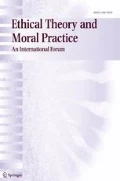Abstract
This paper explores the debate between personists, who argue that the concept of a person if of central importance for moral thought, and personists, who argue that the concept of a human being is of greater moral significance. On the one hand, it argues that normative naturalism, the most ambitious defense of the humanist position, fails to identify moral standards with standards of human behavior and thereby fails to undermine the moral significance of personhood. At the same time, it contends that a more focused attention on the morally relevant features of human life may indeed play a crucial role in enhancing our moral understanding.
Similar content being viewed by others
Notes
In Foot 2001.
See Kripke 1980.
She writes: “We needn’t suppose that an entity must have all of these attributes to be properly considered a person; (1) and (2) alone may well be sufficient for personhood, and quite probably (1)–(3) are sufficient. Neither do we need to insist that any one of these criteria is necessary for personhood, although once again (1) and (2) look like fairly good candidates for necessary conditions, as does (3), if ‘activity’ is construed so as to include the activity of reasoning. All we need to claim, to demonstrate that a fetus is not a person is that any being which satisfies none of (1)–(5) is certainly not a person. I consider this claim to be so obvious that I think almost anyone who denied it, and claimed that a being which satisfied none of (1)–(5) was a person all the same, would thereby demonstrate that he had no notion at all of what a person is—perhaps because he had confused the concept of a person with that of genetic humanity” (1973, pp. 55–6).
In Anscombe 1958.
Williams frames this issue in his characteristically colorful way when he notes that human beings who encountered such creatures and “thought that it was just a question of how we should treat them has seriously underestimated the problem, both ethically and, probably, prudentially” (2006, p. 148).
Thompson does consider the encounters we might have with other kinds of creatures in Thompson 2004b. The argument there is dense and complex, but the core seems to be that there is no context sufficient to ground a shared morality among life-forms that have developed independently. For while life-forms that have developed independently may participate in practices with identical content, those practices will nevertheless be distinct. And as distinct practices, it will not be possible for them to share norms that govern them, even if those norms appear to have the same content. If the scenario I have outlined is possible, then it will represent a possible counterexample to Thompson’s conclusion. Moreover, he does not seem to me to sufficiently consider the possibility of creating new practices among various life-forms that would carry with them values or standards that could likewise be shared.
Scanlon’s work thus focuses on the aspect of morality that involves interpersonal relations. A criticism of those who view morality primarily in terms of our obligations is leveled by Bernard Williams in Williams 1985. I don’t intend to argue here for the inclusion or exclusion of any particular ideals in the realm of the moral. My point is merely that the moral includes our relationships to others, whatever else it includes.
This type if difficulty is explored in Dennett 1976.
References
Anscombe GEM (1958) Modern moral philosophy. In Philosophy 33
Dennett D (1976) Conditions of personhood. In: Rorty AO (ed) The identities of persons. University of California Press, Berkeley
Diamond C (1991) The importance of being human. In: Cockburn D (ed) Human beings. Cambridge University Press, Cambridge
Foot P (2001) Natural goodness. Oxford University Press, Oxford
Hursthouse R (1998) On virtue ethics. Oxford University Press, Oxford
Kripke S (1980) Naming and necessity. Harvard University Press, Cambridge
McMahan J (2002) The ethics of killing. Oxford University Press, Oxford
Mulhall S (2002) Fearful thoughts. In London Review of Books 24, no. 16
Regan T (1983) The case for animal rights. University of California Press, Berkeley
Scanlon TM (1998) What we owe to each other. Harvard University Press, Cambridge
Singer P (1993) Practical ethics, 2nd edn. Cambridge University Press, Cambridge
Thompson M (2008) Life and action. Harvard University Press, Cambridge
Thompson M (2004a) Apprehending human form. In: Anthony O’Hear (ed) Modern moral philosophy. Cambridge University Press, Cambridge, pp 47–74
Thompson M (2004b) What is it to wrong someone? In: Wallace RJ, Phillip Pettit, Samuel Scheffler, Michael Smith (eds) Reason and value. Oxford University Press, Oxford
Thompson M (1995) The representation of life. In: Hursthouse R, Quinn W, Lawrence G (eds) Virtues and reasons: Philippa foot and moral theory. Oxford University Press, Oxford
Tooley M (1972) Abortion and infanticide. Philos Public Aff 2:37–65
Warren MA (1973) On the moral and legal status of abortion. Monist 57:43–61
Williams B (1985) Ethics and the limits of philosophy. Harvard University Press, Cambridge
Williams B (2006) The human prejudice. In Philosophy as a humanistic discipline. Princeton: Princeton University Press
Acknowledgements
I would very much like to thank Talbot Brewer, Charles Matthewes, and Rebecca Stangl, and an anonymous reviewer for their very helpful comments on this paper. I am also indebted to the Institute for Advanced Studies in Culture at the University of Virginia for their collegial and financial support.
Author information
Authors and Affiliations
Corresponding author
Rights and permissions
About this article
Cite this article
Kadlac, A. Humanizing Personhood. Ethic Theory Moral Prac 13, 421–437 (2010). https://doi.org/10.1007/s10677-009-9214-2
Accepted:
Published:
Issue Date:
DOI: https://doi.org/10.1007/s10677-009-9214-2




